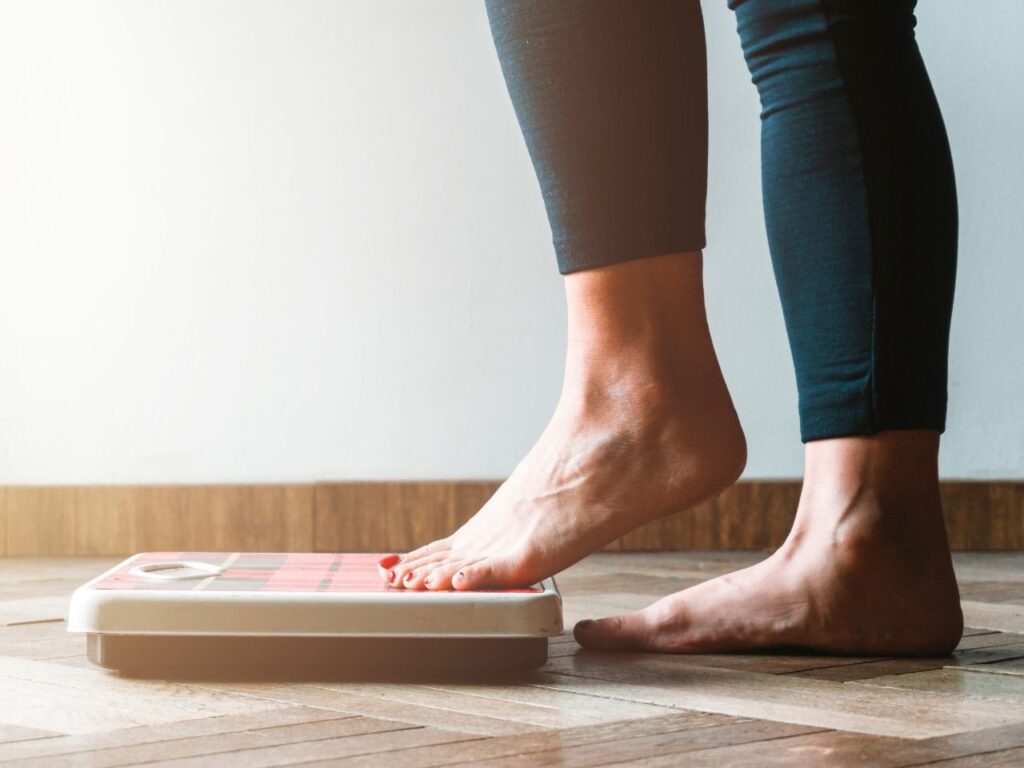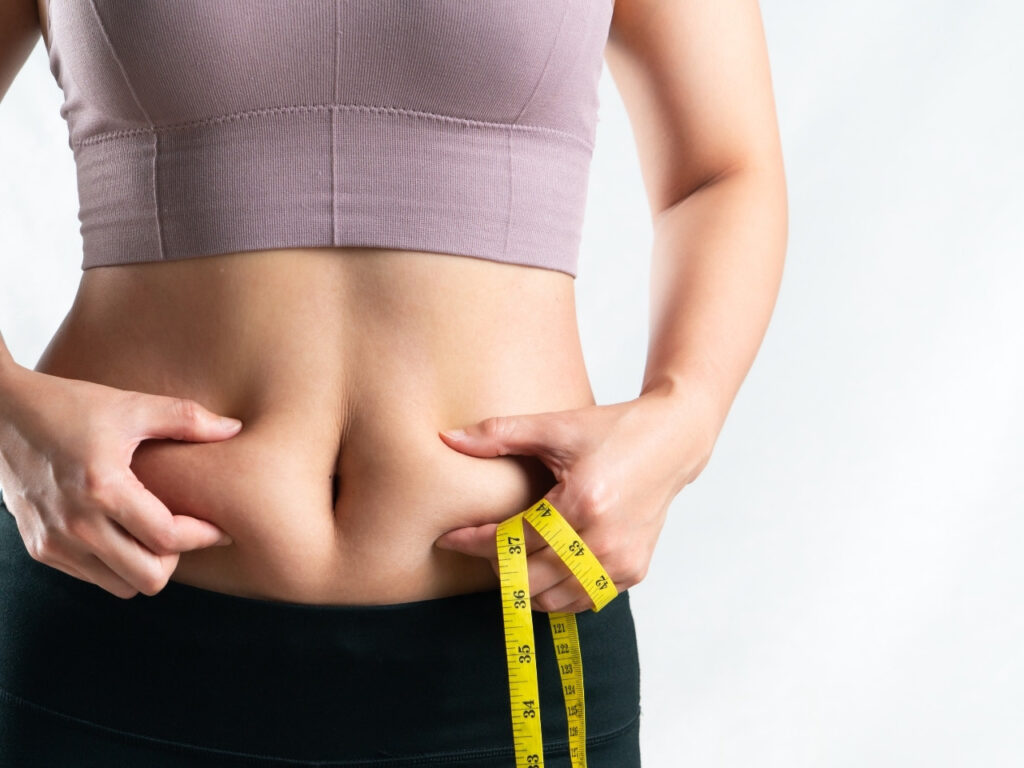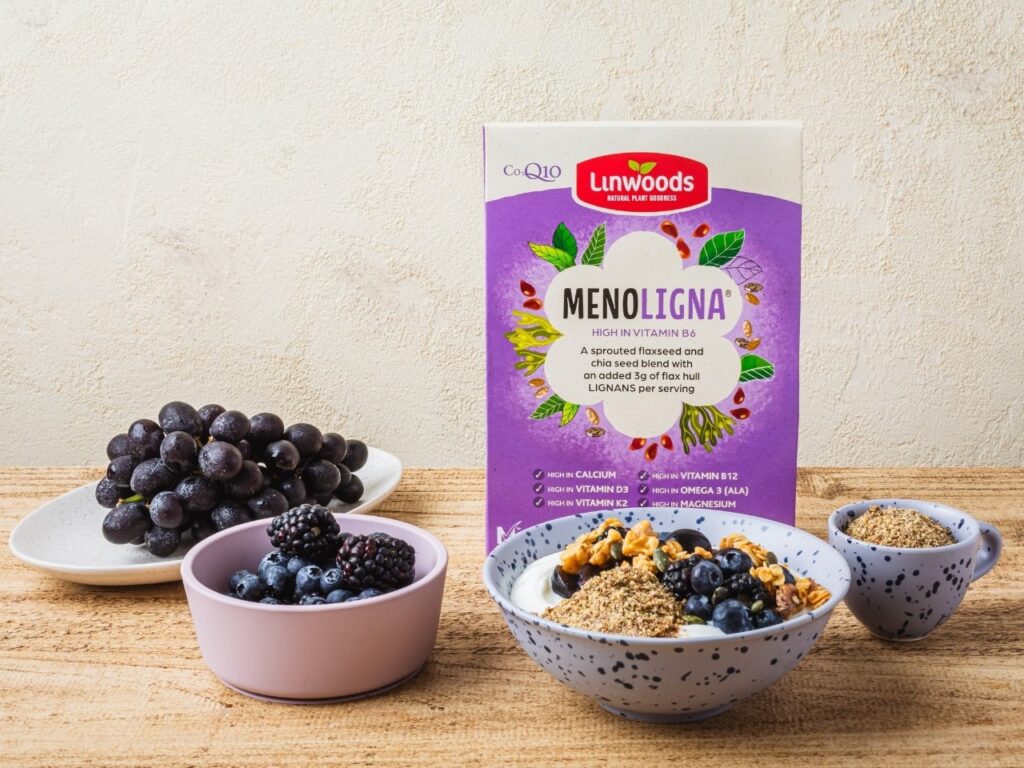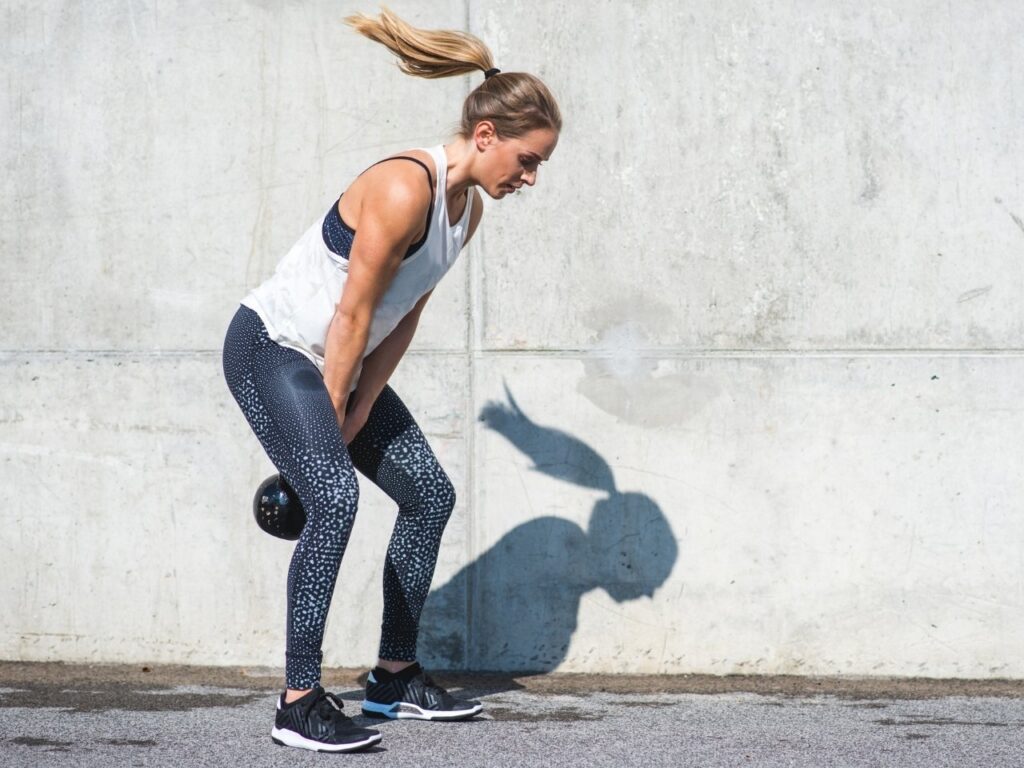If you’ve noticed changes to your weight, your waistline or your body shape in your 40s, you’re not alone. Many women find that, despite eating and exercising the same way they always have, they start gaining weight, especially around the middle. Weight gain and increased belly fat are among the most common and frustrating signs of perimenopause.
Weight gain and belly fat in perimenopause are driven by a complex combination of hormonal changes, muscle loss, increased appetite and shifting body composition.

The good news is: understanding what’s happening inside your body gives you the power to make changes that genuinely support your health, energy and confidence, now and for the decades ahead.
In this comprehensive guide, we’ll explore:
- Why weight gain and belly fat happen during perimenopause
- How nutrition can support healthy weight loss and hormonal balance
- The role of supplements and what can help
- The essential lifestyle changes that make a real difference
Whether you know you’re in perimenopause or you’re simply wondering why your body is changing in your 40s (or beyond), this guide will help you feel informed, empowered and ready to take action.
Why You Gain Weight and Belly Fat in Perimenopause
Weight gain and belly fat in perimenopause are common, but many women don’t fully understand why. If your body has started to change in your 40s — weight creeping up, waistline expanding, body shape shifting — despite eating and exercising the same way you always have, you’re not imagining it. And you’re certainly not alone.
Understanding why these changes happen is empowering. When you know what’s going on inside your body, you can take informed action to support your health, manage your weight and feel like yourself again.
Here are the key reasons why weight gain and belly fat become more common during perimenopause:
1. Hormonal Changes and Weight Gain in Perimenopause
One of the biggest drivers of weight gain and belly fat in perimenopause is the hormonal shift that happens as your body transitions towards menopause. Oestrogen levels start to decline, and the ratio of oestrogen to testosterone changes, prompting your body to store more fat around your middle and less around your hips and thighs.
At the same time, your body produces more of the ‘hunger hormone’ ghrelin, which can increase your appetite. Levels of resistin, a hormone that helps to suppress appetite, fall. These shifts can lead to stronger hunger signals and greater food cravings, even if your diet hasn’t changed.
2. Loss of Muscle Mass (Sarcopenia), Weight Gain and Belly Fat in Perimenopause
From around your 30s onwards, muscle mass naturally declines, but this process can accelerate during perimenopause. As oestrogen levels fall, women begin to lose muscle mass at a rate of 1–3% per year — a process known as sarcopenia. This decline in muscle contributes to a lower metabolic rate and a shift in body composition, especially around the middle.
Muscle is metabolically active tissue, meaning it burns more calories at rest than fat. As you lose muscle, your resting metabolic rate drops, so you burn fewer calories each day, even if your eating and activity levels haven’t changed. This shift can lead to gradual fat gain and changes in body composition, often showing up as increased belly fat. You might notice that your body feels softer or your clothes fit differently. While your weight on the scales may initially stay the same, over time this slower metabolism can also contribute to overall weight gain.
3. Increased Insulin Resistance and Belly Fat in Perimenopause
One of the major contributors to weight gain and belly fat in perimenopause is insulin resistance. This is a condition where your cells become less responsive to insulin, the hormone that helps move glucose (sugar) from your blood into your cells for energy.
Oestrogen plays a key role in how your body uses glucose. As levels decline during perimenopause, your ability to process carbohydrates efficiently — especially in your muscles and brain — also drops. This makes your body more reliant on burning fat for fuel, but only if your cells stay responsive to insulin. Without that responsiveness, the natural shift in energy use becomes harder, leading to higher blood sugar, greater fat storage (particularly belly fat) and lower energy.
This impaired blood sugar control can lead to more pronounced highs and crashes, often triggering stronger cravings, particularly for sugary or refined foods. Over time, this can drive a cycle of fat gain, particularly around the middle.
Several factors raise the risk of insulin resistance in perimenopause, including:
- Loss of muscle mass
- Accumulation of visceral fat (fat stored deep in the abdomen around internal organs)
- Poor sleep
- Chronic stress
- Physical inactivity
- A diet high in refined carbohydrates — such as white bread, white pasta, white rice, white flour and foods made with it (cakes, biscuits, pastries), along with soft drinks, fruit juice, breakfast cereals and sweets — and ultra-processed foods, including packaged snacks, ready meals, protein bars, processed meat and flavoured yoghurts
These risk factors are often interconnected, which helps explain why balancing blood sugar becomes so important during perimenopause, both for managing weight and supporting energy, mood and hormone health.
4. Visceral Fat vs Subcutaneous Fat in Perimenopause
Not all body fat is created equal. Subcutaneous fat is the fat you can pinch just under the skin, while visceral fat is the deeper fat that accumulates around your internal organs inside the abdomen.
During perimenopause, women are more likely to gain visceral fat. This type of fat is metabolically active, meaning it releases hormones and inflammatory substances that can disrupt your metabolism. Over time, this increases the risk of insulin resistance, cardiovascular disease, type 2 diabetes and other chronic health issues.
Even a small increase in visceral fat can have a significant impact on your health — which is why belly fat in perimenopause isn’t just about appearance. It’s a genuine health concern that deserves attention and support.
Tracking Waist Circumference: A Window into Metabolic Health in Perimenopause
Measuring your waist circumference is one way to assess your risk of developing metabolic syndrome — a cluster of conditions that raise your risk of heart disease, stroke and diabetes.
A waist measurement of more than 35 inches (88 cm) in women is associated with higher visceral fat levels and an increased risk of metabolic complications.

5. Other Factors That Contribute to Weight Gain in Perimenopause
Weight gain and belly fat in perimenopause are complex and influenced by many interconnected factors, including:
- Poor sleep: Common in perimenopause and linked to increased hunger, cravings and fat storage
- Chronic stress: Raises cortisol levels, which can promote fat storage around the belly
- Thyroid shifts: Thyroid function can subtly decline, slowing metabolism further
- Depression and mood changes: Can lead to emotional eating or reduced motivation to exercise
- Ageing: Natural changes in metabolism and muscle mass also play a role, independent of hormones
Understanding that all of these factors layer together helps explain why weight management during perimenopause feels so different compared to earlier life stages.
What to Do About Weight Gain and Belly Fat in Perimenopause
If you’re experiencing weight gain and belly fat in your 40s, it’s not because you’re failing or doing something wrong, it’s the result of powerful biological changes happening inside your body.
The empowering part is this: once you understand why these changes are happening, you can take targeted, consistent steps to support your body through nutrition, movement, sleep and mindset — and reclaim your body, strength and confidence.
5 Nutrition Strategies to Target Weight Gain and Belly Fat in Perimenopause
Nutrition plays a crucial role in managing weight gain and belly fat in perimenopause. The hormonal shifts, muscle loss and metabolic changes that happen in your 40s and beyond mean that what worked in your 20s or 30s may no longer be enough.
Rather than turning to extreme diets or restrictive plans, the key is to focus on the right foods — those that support your metabolism, nourish your body and help you preserve muscle while reducing fat.
Here’s how to approach nutrition to support sustainable weight loss and long-term health during perimenopause:
1. Choose Nutrient-Dense Foods to Reduce Belly Fat and Support Weight Loss in Perimenopause
In perimenopause, every calorie counts more. As metabolism slows and muscle mass naturally declines, your body requires fewer calories, but it needs more nutrition. This includes high-quality protein, alongside key vitamins, minerals and essential fatty acids.
That’s why nutrient-dense foods are so important. These are foods that provide a high concentration of protein, vitamins, minerals and other essential nutrients relative to their calorie content.
Animal foods are particularly important for women in perimenopause. They provide:
- Complete proteins with all essential amino acids, including leucine, which is critical for muscle synthesis
- Greater bioavailability of key nutrients like iron, zinc, calcium and vitamin D3
- Nutrients not available in plants, or not in significant amounts to meet daily needs — including DHA, EPA, choline, heme iron, vitamin B12, vitamin D3, iodine and collagen (rich in glycine and important for skin, joint and connective tissue health)
- More protein per calorie than most plant-based options — for example, 100g of steak provides around 26g of high-quality protein for approximately 200 calories, whereas matching this with lentils would require significantly more calories
Plant foods are essential for fibre, phytonutrients and gut health. But relying solely on plant proteins makes it harder to meet your protein needs without consuming more calories than your body requires — especially when maintaining muscle and supporting your metabolism are key.
Plant-based meat alternatives, on the other hand, are often ultra-processed. They may be high in additives, thickeners and industrial seed oils (such as sunflower oil, vegetable oil and rapeseed oil), and offer little real nutritional value. During perimenopause — when your body needs nourishment more than ever — real, whole foods are always the better choice.

2. Prioritise High-Quality Protein to Reduce Belly Fat and Support Healthy Weight in Perimenopause
Prioritising protein becomes non-negotiable in your 40s and beyond. Adequate protein intake helps preserve muscle, support metabolism and regulate appetite, all of which are key to managing weight gain and belly fat in perimenopause.
As oestrogen levels fall, women begin to lose muscle mass at a rate of 1–3% per year, a process known as sarcopenia. This decline in muscle contributes to a lower metabolic rate and a shift in body composition, especially around the middle.
To protect your muscle tissue and metabolic health, you need enough protein — and the right kind. A more optimal intake for women in midlife is around 1 gram of protein per pound of body weight, which works out as 1.6–2.2g per kg. For example, a woman weighing 70kg (around 11 stone or 150 pounds) should aim for approximately 110–150g of protein daily for optimal muscle maintenance and fat loss support.
Why Protein Is So Important in Perimenopause
- Stimulates muscle protein synthesis (especially leucine from animal sources)
- Helps maintain your metabolic rate
- Reduces cravings and supports satiety
- Supports blood sugar balance and insulin sensitivity
What Is High-Quality Protein and Why Does It Matter?
High-quality protein contains all the essential amino acids your body needs to repair and build muscle, most importantly, leucine, a branched-chain amino acid (BCAA) that plays a direct role in stimulating muscle protein synthesis.
Leucine is particularly important for women in midlife because:
- It helps stimulate muscle growth and prevent age-related muscle loss
- It may improve blood sugar balance by supporting glucose uptake and insulin sensitivity
- It helps trigger the muscle repair response after meals and resistance training
Research suggests that the optimal leucine amount for women over 40 is around 3–4g per meal, which corresponds to eating 25–30g of high-quality protein at each meal.
Animal proteins (meat, fish, eggs, dairy and whey) are naturally rich in leucine and more effective at stimulating muscle synthesis compared to plant sources.
Protein Density: Why It’s Harder with Plant-Based Sources
Protein density refers to how much protein a food provides relative to its calorie content. This matters in perimenopause, when you need more nutrition from fewer calories.
Animal proteins like eggs, chicken, meat, fish or Greek yoghurt are highly protein-dense. For example:
- 100g chicken breast = ~31g protein, ~165 kcal
- 100g sirloin steak = ~26g protein, ~250 kcal
In contrast, many plant-based proteins like beans or nuts are less protein-dense and often come with significantly more carbohydrates or fats. For example:
- 100g cooked lentils = ~9g protein, ~116 kcal
- 100g almonds = ~21g protein, ~579 kcal
This means it can be challenging to meet your protein goals with plant foods alone, especially without over-consuming calories.
That’s why in midlife, it makes sense to prioritise animal proteins for muscle maintenance, fat loss and overall metabolic health. Plant-based proteins — such as lentils, chickpeas and tofu — can complement your intake and are also excellent sources of fibre and phytoestrogens, both of which offer additional benefits for hormonal balance and gut health. However, relying on them entirely may not be the most efficient strategy for meeting your protein needs without over-consuming calories.

3. Manage Blood Sugar to Prevent Weight Gain and Belly Fat in Perimenopause
Managing blood sugar is one of the most effective nutrition strategies for preventing weight gain and reducing belly fat in perimenopause. When your blood sugar is stable, you’re less likely to experience cravings, energy crashes or increased fat storage, all of which are common when insulin resistance creeps in during your 40s.
Unstable blood sugar can trigger a range of symptoms, including:
- Cravings (especially for refined carbohydrates or sugar)
- Headaches
- Irritability or ‘hanger’
- Dizziness or lightheadedness
- Brain fog
- Energy dips and fatigue shortly after eating
To help stabilise blood sugar and support insulin sensitivity, focus on the structure of your meals and your eating patterns. Try these strategies to support blood sugar regulation throughout the day:
- Build every meal around protein and healthy fats — Protein slows the release of glucose into your bloodstream, while fat helps you stay fuller for longer. Aim for a portion of high-quality protein and 1–2 tablespoons of healthy fat (like avocado, nuts, seeds, olive oil, full-fat Greek yoghurt or a few olives) at each meal.
- Add plenty of fibre-rich, non-starchy vegetables — These support digestion, gut health and satiety, while helping to slow the release of glucose.
- Swap refined carbohydrates for wholegrains, legumes or root vegetables — These options provide more fibre and nutrients. Stick to a side portion (around 100–150g cooked) to avoid blood sugar spikes and support portion control.
- Avoid sugary snacks, fruit juice and fizzy drinks — These can quickly spike blood sugar and drive cravings.
- Space your meals — A balanced meal should keep you satisfied for 4–5 hours. Grazing or snacking frequently can reduce metabolic flexibility — your body’s ability to switch between glucose and fat for fuel.
- Sprinkle Ceylon cinnamon on meals like oats or yoghurt — it may help improve insulin sensitivity and reduce blood sugar spikes.
- Stay hydrated — Dehydration can sometimes be mistaken for hunger and may negatively affect blood sugar regulation.
By building balanced meals and being mindful of how you eat, you can support blood sugar balance — helping to reduce cravings, improve energy and make weight management in perimenopause easier.

4. Don’t Forgo Fibre: Your Midlife Superpower
Fibre is critical for gut health, hormone balance and sustainable weight management in perimenopause. Getting enough fibre can help:
- Feed your beneficial gut bacteria (including the oestrobolome, which plays a role in oestrogen metabolism)
- Promote satiety, helping you feel fuller for longer
- Support healthy digestion and regular bowel movements
- Stabilise blood sugar levels to reduce cravings and energy dips
Most women should aim for at least 30g of fibre per day from whole foods to support digestive health, blood sugar balance and hormonal wellbeing during perimenopause.
Soluble vs Insoluble Fibre: Why Both Matter
There are two main forms of fibre, both of which offer distinct and important benefits.
Soluble Fibre
- Dissolves in water to form a gel-like substance
- Slows digestion and helps stabilise blood sugar
- Feeds friendly gut bacteria
- Helps lower cholesterol
Top sources: oats, beans, lentils, pears, apples, citrus fruits, carrots, prunes, flaxseeds, chia seeds
Insoluble Fibre
- Does not dissolve in water
- Adds bulk to stool and supports regular bowel movements
- Helps prevent constipation
Top sources: wholegrains (like brown and wild rice and quinoa), nuts, seeds, leafy greens, vegetables with skins (e.g. sweet potatoes, carrots, courgettes, green beans), sweetcorn
A Simple Strategy for Fibre in Perimenopause
Aim to eat a wide variety of plant-based whole foods every day, including plenty of vegetables, fruit, wholegrains, legumes, nuts and seeds. This naturally provides both soluble and insoluble fibre, which supports digestion, blood sugar balance, metabolism and hormone health in perimenopause.
A helpful goal is 8 portions of vegetables per day (think 2 at breakfast, 3 at lunch and 3 at dinner) with 1–2 optional servings of fruit, ideally enjoyed as dessert.

5. Develop Calorie Awareness to Support Weight Loss and Reduce Belly Fat in Perimenopause
One of the most powerful tools for managing weight gain and belly fat in perimenopause is building awareness around your nutrition and that includes understanding calories.
Calories are simply a measure of the energy food provides. Tracking them isn’t about restriction or punishment, but about learning. A helpful mantra is, “what gets measured gets managed.”
To lose body fat, you need to be in a calorie deficit — meaning you consistently consume slightly fewer calories than your body uses. This doesn’t mean eating less food overall, but eating more of the right foods: nutrient-dense, protein-rich, high-fibre meals that support satiety, metabolism and hormone balance.
Tracking your intake — even for a few days — can help you:
- Understand your energy needs in midlife
- Spot hidden calories (e.g. snacks, drinks, processed foods)
- Learn how protein, fibre and healthy fats support your goals
Used mindfully, tracking becomes a powerful act of self-care and insight — not restriction.
How to Start: A Simple 3-Step Approach
1. Set Your Protein Target
Aim for 1 gram of protein per pound of body weight (or 2.2g/kg). This helps preserve muscle, regulate appetite and support metabolism.
2. Estimate Your Daily Calorie Needs
Use the following formula to estimate your Total Daily Energy Expenditure (TDEE):
Step A: Calculate your Basal Metabolic Rate (BMR)BMR = (10 × weight in kg) + (6.25 × height in cm) – (5 × age) – 161
Step B: Multiply your BMR by your activity level
| Activity Level | Description | Multiplier |
|---|---|---|
| Sedentary | Little/no exercise | 1.2 |
| Lightly active | Light exercise 1–3 days/week | 1.375 |
| Moderately active | Moderate exercise 3–5 days/week | 1.55 |
| Very active | Hard exercise 6–7 days/week | 1.725 |
| Super active | Physical job or very hard training | 1.9 |
TDEE = BMR × Activity Multiplier
3. Create a Sustainable Calorie Deficit
Subtract 300–500 calories from your TDEE for healthy, steady fat loss.
No need to add back exercise calories — your activity is already factored in.
Tips for Tracking with Confidence
- Use tracking for education, not perfection or judgement
- Use a free app like MyFitnessPal to track your meals and snacks
- Weigh or measure foods initially to improve portion awareness
- Track everything — even small extras like milk in tea or bites of food
- Focus on hitting your protein target first — it’s key for body composition
Calorie awareness is not about dieting — it’s about understanding how food fuels your body. In perimenopause, this insight becomes even more valuable. When you combine nutrient-dense meals with the right amount of protein and a gentle calorie deficit, you’ll be supporting fat loss, preserving muscle and optimising your energy.
Top 10 Foods to Prioritise for Weight Loss in Perimenopause
What you eat in perimenopause can make a real difference to your hormones, metabolism and waistline. These nutrient-dense, hormone-supportive foods help stabilise blood sugar, support muscle maintenance and reduce fat storage, especially around the middle.
1. High-quality animal proteins
Meat, fish, poultry and eggs provide complete protein and the amino acid leucine, which is essential for muscle protein synthesis and maintaining metabolic rate.

2. Oily fish rich in omega-3s
Salmon, sardines and mackerel help reduce inflammation, support hormone production and may improve fat distribution, particularly around the belly.
3. Colourful non-starchy vegetables
Leafy greens, broccoli, peppers, aubergine and courgette are rich in fibre and antioxidants. They add volume and nutrients with minimal calories, promoting satiety and stable blood sugar.

4. Fibre-rich root vegetables
Carrots, beetroot, parsnips and sweet potatoes provide slow-digesting carbohydrates and fibre to balance blood sugar and reduce cravings.
5. Wholegrains
Oats, quinoa, buckwheat and brown rice support blood sugar balance and hormone health with fibre, B vitamins and sustained energy.

6. Legumes
Lentils, chickpeas, black beans and butter beans offer plant-based protein, fibre and phytoestrogens, which may help balance hormones and reduce belly fat.
7. High-quality plant proteins
Organic tofu and tempeh provide complete plant-based protein and phytoestrogens, supporting muscle maintenance and hormone balance without excess calories.
8. Healthy fats
Extra virgin olive oil, avocado, nuts, seeds and organic full-fat dairy support satiety, hormone production and insulin sensitivity.

9. Low-glycaemic fruits
Berries, apples, pears, plums and kiwi are rich in fibre and antioxidants. They support blood sugar control and satisfy sweet cravings without spikes.
10. Phytoestrogen-rich foods
Flaxseeds, lentils, tofu and tempeh contain plant compounds that gently mimic oestrogen. They may help support hormonal balance and reduce belly fat during perimenopause.
5 Foods to Avoid for Weight Loss in Perimenopause
What you don’t eat can be just as important as what you do. These foods can disrupt blood sugar balance, promote fat storage (especially around your middle), and contribute to inflammation, cravings and hormonal imbalances. Avoiding or reducing them helps create space for nourishing, nutrient-dense choices that truly support your body in perimenopause.
1. Ultra-Processed Foods (UPFs)
UPFs are industrially manufactured products made with additives, emulsifiers and low-quality oils. They are designed to be hyper-palatable but often lack real nutrition.
Examples:
- Packaged snacks (crisps, granola bars)
- Flavoured yoghurts, ready meals, protein bars
- Plant-based meat alternatives
- Instant noodles and soups
Also watch out for industrial seed and vegetable oils (sunflower, vegetable, rapeseed, grapeseed), which are commonly used in UPFs and contribute to inflammation.
2. Trans Fats
Trans fats increase inflammation, promote fat storage and are linked to heart disease and insulin resistance. The main culprits are hydrogenated vegetable oils found in:
- Margarine and spreadable butter substitutes
- Shop-bought cakes, biscuits and pastries
- Processed frostings and microwave popcorn
Always check labels for “partially hydrogenated oils”.
3. Refined Carbohydrates
These rapidly spike blood sugar and can worsen insulin resistance — a major driver of belly fat in perimenopause. They also lack fibre and nutrients.
Examples:
- White bread and pasta
- White rice
- Pastries, crackers and breakfast cereals
- Foods made with white flour
4. Sugar and Sugary Foods
Excess sugar drives blood sugar instability, increases cravings and makes it harder to lose weight. Over time, it worsens insulin resistance and disrupts hormone balance.
Examples:
- Sweets, chocolate, cakes
- Biscuits and desserts
- Syrups, sweet spreads
- Flavoured yoghurts and fruit juices
5. Alcohol
Even moderate drinking can disrupt fat metabolism, increase oestrogen levels and interfere with sleep — all of which make it harder to lose weight and balance hormones. It also contributes “empty” calories that add up quickly.
Choosing real, whole foods as often as possible gives your body the nutrients it needs — without the inflammatory, blood sugar–spiking effects of ultra-processed and refined foods that work against your health in perimenopause.
Supplements to Support Weight Loss and Reduce Belly Fat in Perimenopause
Supplements aren’t a shortcut to fat loss — and they’re no substitute for a nutrient-dense diet, daily movement and balanced lifestyle habits. But they can support your progress during perimenopause, when hormonal shifts, muscle loss and blood sugar dysregulation can make it harder to maintain a healthy weight.
The right supplements can help preserve lean muscle, regulate appetite, support blood sugar balance, improve sleep and reduce cravings — all key factors when your metabolism is changing.
Think of supplements as a helpful layer on top of strong foundations. When used alongside real food and smart habits, they can enhance your results in a safe, supportive way.
The supplements below are tailored to support women navigating weight changes during perimenopause.
Meeting your protein needs is essential in perimenopause, but many women struggle to consistently reach optimal intake through food alone — especially at breakfast or on busy days.
1. Organic Whey Protein Powder
A high-quality protein powder can help you hit your targets more easily and support muscle, metabolism and appetite regulation.
Why it helps:
- Supports muscle maintenance and growth — key for a healthy metabolism and body composition
- Provides a convenient source of leucine, the amino acid needed to stimulate muscle protein synthesis
- Promotes satiety and reduces cravings, helping you feel fuller for longer
Best choices:
- Grass-fed whey protein isolate or concentrate — rich in leucine, low in carbohydrates and fats
- Collagen + leucine — for those who can’t tolerate dairy (note: collagen alone isn’t a complete protein)
- High-quality plant-based protein blends — such as organic pea or hemp (only if needed; avoid those with added sugars or fillers)
Top tip: Choose a protein powder that delivers at least 25–30g of protein and 2.5–3g of leucine per serving to maximise the benefits for muscle preservation and fat loss.

2. Creatine Monohydrate
Creatine is one of the most well-researched supplements for supporting muscle strength, body composition and even brain health — making it especially valuable for women in perimenopause and beyond.
Why it helps:
- Preserves muscle strength and mass, protecting against age-related decline
- May improve metabolic health and glucose tolerance
- Emerging research suggests benefits for brain function, including memory, focus and mood

3. Omega-3 Fatty Acids (Fish Oil)
Omega-3 fatty acids — especially EPA and DHA found in oily fish — offer powerful benefits that support weight management, hormone balance and long-term health during perimenopause.
Why it helps:
- Reduces inflammation, which can contribute to insulin resistance and belly fat
- Supports fat metabolism and may help shift body composition
- Protects heart, brain and joint health — all increasingly important as we age
Best choices:
- A high-quality fish oil supplement with a concentrated dose of EPA and DHA
- Choose a product that’s third-party tested for purity, potency and sustainability
Top tip:
Aim for 1000–2000mg of combined EPA and DHA daily. If you have a health condition or take medications, check with your healthcare provider first.
4. Magnesium
Magnesium is one of the most important — and most commonly depleted — minerals during perimenopause. Stress, poor sleep, busy lifestyles and even modern farming practices can all contribute to suboptimal magnesium levels. Yet this essential mineral supports over 300 enzyme processes in the body, many of which are directly linked to weight management and hormone balance.
Why it helps:
- Supports blood sugar regulation and improves insulin sensitivity — helping reduce belly fat and prevent energy crashes
- Improves sleep quality by calming the nervous system and regulating melatonin, which can reduce late-night snacking and support appetite control
- Helps lower cortisol levels, reducing stress-related fat storage around the belly
- Contributes to energy production, muscle function, mood and cognitive balance — all of which can suffer during midlife
- Supports strong bones and teeth, and helps maintain normal nervous system function
Best choices:
Look for magnesium supplements that combine multiple highly bioavailable forms, such as:
- Magnesium glycinate — ideal for calming the nervous system and supporting deep, restorative sleep
- Magnesium malate — known for its role in energy production and muscle recovery
- Magnesium taurate — supports cardiovascular health and may help regulate mood
Top tip:
Aim for a total daily dose of around 300–400mg, ideally from a blend of well-absorbed forms. If you’re new to magnesium or prone to digestive sensitivity, start on the lower end and take it with food to reduce the risk of stomach upset.

5. Chromium Picolinate
Chromium is a trace mineral that helps improve how your body uses insulin, making it easier to regulate blood sugar and manage appetite — two key factors in preventing weight gain and belly fat in perimenopause.
Why it helps:
- Supports healthy insulin function and glucose metabolism
- May reduce cravings, particularly for sugar and refined carbohydrates
- Can contribute to better blood sugar stability throughout the day
Best choice:
Chromium picolinate — the most bioavailable and widely studied form
Tip:
A typical dose is 200–400mcg per day. It’s most effective when used alongside a blood sugar–balancing diet rich in protein, healthy fats and fibre.
6. Probiotics (Strain-Specific)
Gut health impacts nearly every aspect of hormonal balance and metabolism — including how your body stores fat. Research now shows that specific probiotic strains may help reduce abdominal fat and support metabolic health during perimenopause.
Why it helps:
- Supports a healthy oestrobolome — the gut bacteria involved in oestrogen metabolism
- May reduce inflammation and improve insulin sensitivity
- Certain strains have been linked to reductions in belly fat and waist circumference
Best choices:
Probiotic supplements containing researched strains such as Lactobacillus gasseri, Lactobacillus rhamnosus and Bifidobacterium breve
Tip:
Choose a product with clinically studied strains (not just high CFUs) and pair it with a fibre-rich, plant-diverse diet to help beneficial bacteria thrive.

Key Takeaways on Supplements to Target Weight Gain and Belly Fat in Perimenopause
Targeted supplements can support your efforts to reduce belly fat and manage weight in perimenopause — when layered on top of a nutrient-dense diet and healthy lifestyle. From protein powder and creatine to omega-3s and chromium, the right supplements may help you preserve muscle, balance blood sugar and reduce cravings. While they’re not magic pills, they can enhance your results and make your journey more effective.
Top 5 Lifestyle Strategies to Support Weight Loss and Belly Fat in Perimenopause
Optimising your nutrition is foundational — but meaningful, lasting change happens when you pair it with the right lifestyle habits. Strength training, daily movement, quality sleep and stress management can dramatically amplify your results, helping you build muscle, reduce fat and feel stronger, fitter and more energised in your 40s and beyond.
The goal isn’t perfection — it’s creating sustainable habits you can stick with for life.
1. Strength Training to Build Muscle and Boost Metabolism in Perimenopause
One of the most effective ways to combat weight gain and belly fat in perimenopause is through strength training. As oestrogen declines, women naturally lose muscle mass, which slows metabolism, reduces strength and contributes to changes in body composition.
Strength training helps you:
- Build and maintain lean muscle mass (critical for fat loss and metabolic health)
- Increase resting metabolic rate, so you burn more calories even at rest
- Improve insulin sensitivity, making it easier to manage blood sugar and reduce fat storage
- Protect bone density and support long-term joint health
The more muscle you maintain, the easier it becomes to manage your weight and health as you move through perimenopause and beyond.
Aim to strength train 3–4 times per week for the best results. Focus on compound movements that recruit multiple muscle groups, such as:
- Squats
- Deadlifts
- Lunges
- Rows
- Push-ups
You can use dumbbells, resistance bands, bodyweight or kettlebells — a versatile tool that builds strength, stability and cardiovascular fitness in one workout.
You don’t need to lift heavy right away. Start with manageable weights, prioritise proper form, and gradually increase resistance over time. Progression and consistency are key.

2. Move Your Body Daily to Support Optimal Weight and Fat Loss in Perimenopause
Daily movement is one of the most powerful and accessible tools for managing weight gain and belly fat in perimenopause. While structured workouts are beneficial, it’s consistent, intentional movement that truly makes the difference.
Walking is one of the most effective forms of movement you can prioritise every day. It’s low impact, supports blood sugar control, lowers cortisol and boosts mood, all without placing extra stress on the body. Walking after meals can be especially powerful for managing blood sugar and supporting fat metabolism.
In addition to walking, aim to include moderate aerobic activities you enjoy, like cycling, swimming, dancing, or low-impact classes. These boost cardiovascular health, aid fat burning and support mood and motivation.
Aim for:
- A daily step goal of around 10,000 (or build up gradually from your current baseline)
- At least 2–3 sessions of moderate aerobic movement per week, based on what feels good for your body
The key isn’t perfection — it’s consistency. Movement should feel supportive, not punishing.

3. Improve Sleep Quality — to Reduce Cravings, Support Blood Sugar and Promote Fat Loss in Perimenopause
Sleep is often overlooked, but it plays a critical role in managing weight gain and belly fat in perimenopause. Hormonal changes can disrupt sleep quality and duration — and poor sleep has a knock-on effect on nearly every aspect of your health.
Inadequate or disrupted sleep can:
- Increase ghrelin, the hunger hormone, and decrease leptin, the hormone that signals fullness
- Drive cravings, particularly for high-sugar, high-carb foods
- Lower insulin sensitivity, making fat storage (especially around the belly) more likely
- Increase cortisol levels, which can further disrupt blood sugar and fat metabolism
To optimise sleep during perimenopause:
- Stick to a consistent bedtime and wake time — even on weekends
- Keep your bedroom cool, dark and quiet
- Avoid caffeine after lunchtime
- Reduce screen time in the evening and avoid blue light exposure before bed
- Don’t eat large meals or drink alcohol close to bedtime
Even small improvements to your sleep habits can have a big impact on your weight, cravings, mood and overall wellbeing.
4. Manage Stress to Prevent Weight Gain and Belly Fat in Perimenopause
Stress is more than just a feeling — it has a direct physiological impact on your hormones, metabolism and weight, especially during perimenopause.
Chronic stress raises cortisol levels, which:
- Promotes fat storage around the belly
- Increases blood sugar and insulin levels
- Disrupts sleep and appetite regulation
- Contributes to hormonal imbalances that make weight management harder
Managing stress doesn’t mean eliminating it entirely — it’s about building resilience through consistent daily habits that calm your nervous system.
Effective strategies include:
- Taking a daily walk, ideally in nature
- Strength training, yoga or other forms of mindful movement
- Deep breathing exercises or vagus nerve toning
- Mindfulness, meditation or guided relaxation
- Journaling to process emotions and reduce mental load
Finding what helps you feel grounded and calm is key. Stress management isn’t optional during perimenopause — it’s an essential pillar of hormonal balance, metabolic health and long-term weight management.
5. Cultivate a Positive Midlife Mindset for Sustainable Weight Loss in Perimenopause
Mindset is the hidden engine behind every sustainable health change — especially during perimenopause, when your body, hormones and emotions are shifting.
Instead of restriction and perfection, the key is compassion, curiosity and empowerment.
Reframe your mindset around nutrition and weight loss:
- Swap “I can’t have that” for “I choose not to have that because it doesn’t serve me”
- Understand that calorie awareness is a tool for learning, not a form of punishment
- Focus on how food makes you feel — energised, balanced, nourished — instead of just the number on the scale
- View strength training as a form of self-respect and longevity, not a task to shrink your body
- Embrace the idea that midlife isn’t about getting your 20s body back — it’s about becoming strong, vibrant and resilient now
- Your mindset matters just as much as your meal plan or workout schedule. When you feel empowered, progress becomes sustainable.
Your mindset matters just as much as your meal plan or workout schedule. When you feel empowered, progress becomes sustainable.
Lifestyle: An Essential Tool for Managing Weight Gain and Belly Fat in Perimenopause
When it comes to managing weight and belly fat in perimenopause, nutrition is only part of the picture. Lifestyle habits, including strength training, daily movement, restorative sleep, stress management and a positive mindset, play a vital role in supporting your hormones, metabolism and body composition.
By building consistent, supportive routines into your day, you create the foundations for lasting change. Start where you are, take small steps and remember: your daily choices shape your long-term results.
Rescript Your Body, Your Health and Your Midlife
Gaining weight and developing belly fat in perimenopause may be common — but it’s not inevitable. This phase of life brings real biological changes, but it also offers an opportunity: to take ownership of your health and make empowered, evidence-based choices that support your body through midlife and beyond.
At The Menopause Kitchen, we believe that while menopause is inevitable, its impact on your health doesn’t have to be. Through our unique philosophy — Menopause. Food. Life. — we help women rescript their experience of this transition with clarity, confidence and compassion.
- Menopause – You now understand what’s driving the changes in your body: shifting hormones, declining muscle mass, insulin resistance and more. Awareness is power.
- Food – You’ve learned how nutrient-dense, protein-rich, fibre-filled meals can help balance your blood sugar, reduce cravings, support muscle maintenance and minimise fat gain — especially around the belly.
- Life – You’ve seen how strength training, daily movement, restorative sleep, stress reduction and a positive mindset can amplify your results and support long-term wellbeing.
These aren’t quick fixes — they’re long-term strategies rooted in nourishment, strength and self-respect.
And this is what Menopause.Rescripted is all about.
Our membership supports you with the tools, recipes, guidance and community you need to make these changes feel possible — and sustainable.
Because perimenopause isn’t a decline.
It’s a recalibration.
You don’t have to lose your body, your confidence or your sense of self.
You can rescript your story and step into midlife feeling stronger, healthier and more empowered than ever before.